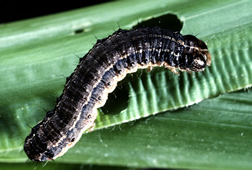This page has been archived and is being provided for reference purposes only. The page is no longer being updated, and therefore, links on the page may be invalid.
|
|
|
|
Natural Enzyme Deters Fall Armyworms and Other Corn-feeding Insects
By Jan SuszkiwFebruary 22, 2007
Furnishing corn plants with genes for producing the enzyme •-N-acetyl hexosaminidase (NAHA) may offer a way to fend off mold-spreading caterpillars and beetles, Agricultural Research Service (ARS) studies suggest.
After hatching from eggs, fall armyworm caterpillars feed on corn plant leaves before advancing on the ears, where succulent kernels await. Other caterpillars and beetle pests feed there, too. When husks are chewed open, kernels can become exposed to mycotoxin-producing fungi. Insecticide spraying within label recommendations helps prevent such feeding and contamination. But the practice can be costly to use and harmful to beneficial insects.
As a possible alternative, ARS scientists Pat Dowd, Eric Johnson and Scott Pinkerton are testing modified strains of corn that produce NAHA throughout the crop plant's tissues. In laboratory trials at the ARS National Center for Agricultural Utilization Research in Peoria, Ill., 100 percent of newly hatched fall armyworms that ingested NAHA-containing leaf tissue from some of the modified corn plants being studied died within three days.
The degree to which the caterpillars stopped feeding on all of the modified corn plants depended on how much NAHA the plants actually produced, the scientists observed. Corn earworm caterpillars, another pest they tested, were also adversely affected by NAHA-containing plants.
The team's examination of NAHA and other enzymes like it is part of a broader effort at the ARS center to develop novel ways of shielding corn from mycotoxin contamination, which costs farmers and processors millions of dollars annually in losses. Of particular interest is determining effective combinations of corn-derived genes that confer insect-resistance levels equal to those in corn containing the biopesticide Bacillus thuringiensis (Bt), but that act against a wider range of pests.
Before studying NAHA-modified corn plants, the scientists used a purified form of the enzyme derived from jack beans, Canavalia ensiformis. They consider NAHA a promising defense for corn because it occurs in foods eaten by humans, such as cabbage and apple, and it targets chitin, a key component of insects but not of humans or other animals.
ARS is the U.S. Department of Agriculture's chief scientific research agency.

